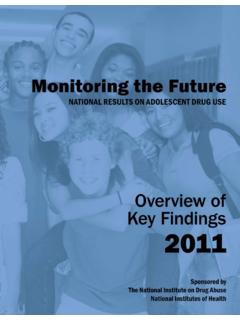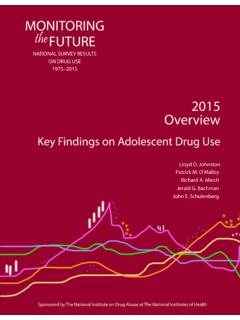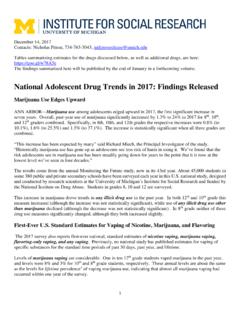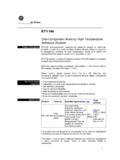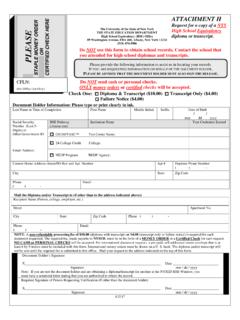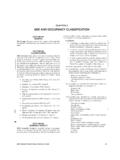Transcription of MONITORING the FUTURE
1 MONITORING . the FUTURE . NATIONAL SURVEY RESULTS. ON DRUG USE. 1975-2017. 2017. Volume 1. Secondary School Students Richard A. Miech Lloyd D. Johnston Patrick M. O'Malley Jerald G. Bachman John E. Schulenberg Megan E. Patrick Sponsored by The National Institute on Drug Abuse at The National Institutes of Health MONITORING THE FUTURE . NATIONAL SURVEY RESULTS ON DRUG USE, 1975 2017. Volume I. Secondary School Students by Richard A. Miech, Lloyd D. Johnston, Patrick M. O'Malley, Jerald G. Bachman, John E. Schulenberg, Megan E. Patrick, The University of Michigan Institute for Social Research Sponsored by: The National Institute on Drug Abuse National Institutes of Health This publication was written by the principal investigators and staff of the MONITORING the FUTURE project at the Institute for Social Research, the University of Michigan, under Research Grant No. R01. DA 001411 from the National Institute on Drug Abuse. The findings and conclusions in this report are those of the authors and do not necessarily represent the views of the National Institute on Drug Abuse or the National Institutes of Health.
2 Public Domain Notice All materials appearing in this volume are in the public domain and may be reproduced or copied, whether in print or in non-print media including derivatives, in any reasonable manner, without permission from the authors. If you plan to modify the material, please indicate that changes were made and contact MTF at for verification of accuracy. Citation of the source is appreciated, including at least the following: MONITORING the FUTURE , Institute for Social Research, University of Michigan. Recommended Citation Miech, R. A., Johnston, L. D., O'Malley, P. M., Bachman, J. G., Schulenberg, J. E., & Patrick, M. E. (2018). MONITORING the FUTURE national survey results on drug use, 1975 2017: Volume I, Secondary school students. Ann Arbor: Institute for Social Research, The University of Michigan. Available at #monographs Institute for Social Research The University of Michigan Ann Arbor, Michigan Published June 2018. ABBREVIATED CONTENTS*. Click on any item below (in blue) to go directly to that page.
3 Detailed Contents .. iv List of Tables .. ix List of Figures .. xix Chapter 1 Introduction .. 1. Chapter 2 Key Findings in 2017 .. 10. Chapter 3 Study Design and Procedures .. 16. Chapter 4 Prevalence and Frequency of Drug Use .. 30. Chapter 5 Trends in Drug Use .. 106. Chapter 6 Initiation Rates and Trends in Initiation Rates .. 279. Chapter 7 Degree and Duration of Drug Highs .. 319. Chapter 8 Attitudes and Beliefs about Drug Use .. 344. Chapter 9 The Social Context .. 421. Chapter 10 Study Publications .. 501. Appendix A Prevalence and Trend Estimates Adjusted for Absentees and Dropouts .. 516. Appendix B Definition of Background and Demographic Subgroups .. 527. Appendix C Trends in Specific Subclasses of Hallucinogens, Amphetamines, Tranquilizers, Narcotic Drugs other than Heroin, and 531. Appendix D Trends in Drug Use for Three Grades Combined .. 549. *See next page for Detailed Contents. iii DETAILED CONTENTS. Click on any item below (in blue) to go directly to that page.
4 Chapter 1 Introduction .. 1. Content Areas Covered .. 2. Drug Classes .. 2. Attitudes, Beliefs, and Early Experiences .. 3. Over-the-Counter Substances .. 3. Cumulative Lifetime Daily Marijuana Use .. 4. Trends in Use of Specific Alcoholic Beverages .. 4. Sources of Prescription Drugs .. 4. Synopses of Other MTF Publications .. 4. Appendixes .. 4. Purposes and Rationale for This Research .. 5. Chapter 2 Key Findings in 2017 .. 10. Executive Summary .. 10. Illicit Drugs showing an Increase in Use in 2017 .. 10. Illicit Drugs Showing Declines in Use in 2017 .. 11. Most Illicit Drugs Held Steady in Use in 12. Psychotherapeutic Drugs .. 12. Most Forms of Tobacco Use Continue to Decline .. 12. Vaping .. 14. Alcohol Use Levels After a Long 15. Chapter 3 Study Design and Procedures .. 16. Research Design and Procedures for the 12th-Grade Surveys .. 16. The Population under Study .. 16. The Omission of 17. Sampling Procedures and Sample Weights .. 17. Questionnaire 18. Questionnaire Format.
5 18. Research Design and Procedures for the 8th- and 10th-Grade Surveys .. 18. Mode of Administration .. 19. Questionnaire Forms and Sample Proportions .. 19. Research Design and Procedures for the 12th-Grade Follow-up Surveys .. 20. Follow-Up Procedures .. 20. Follow-Up Questionnaire Format .. 21. Representativeness and Sample Accuracy .. 21. School Participation .. 21. Student 23. Sampling Accuracy of the Estimates .. 24. Panel Surveys .. 24. Validity of Measures of Self-Reported Drug Use .. 24. Consistency and Measurement of Trends .. 26. iv DETAILED CONTENTS (continued). Click on any item below (in blue) to go directly to that page. Chapter 4 Prevalence and Frequency of Drug Use .. 30. Prevalence and Frequency of Drug Use in 2017: All Students .. 30. Prevalence of Lifetime, Annual, and 30-Day Use .. 30. Frequency of Lifetime, Annual, and 30-Day Use .. 39. Prevalence of Current Daily Use .. 40. Noncontinuation Rates .. 41. Prevalence Comparisons for Important Subgroups .. 42.
6 Gender Differences .. 42. Differences Related to College Plans .. 45. Regional Differences .. 46. Differences Related to Population 48. Differences Related to Parental Education .. 49. Racial/Ethnic Differences .. 50. Interactions between Race/Ethnicity and Parental Education .. 53. Chapter 5 Trends in Drug Use .. 106. Two Themes in Drug Trends from 1975 2017 .. 106. Trends in Prevalence of Use, 1975 107. Trends in Indices of Overall Illicit Drug Use .. 107. Trends in Use of Specific Drugs .. 109. Summary .. 127. Trends in Noncontinuation Rates: 12th Graders .. 128. Implications for Prevention .. 131. Trend Comparisons among Subgroups .. 131. Trend Differences by Gender .. 132. Trend Differences by College Plans .. 139. Trend Differences by Region of the Country .. 145. Trend Differences by Population Density .. 150. Trend Differences by Socioeconomic Status .. 155. Racial/Ethnic Differences in Trends .. 161. Chapter 6 Initiation Rates and Trends in Initiation Rates .. 279. Incidence of Use by Grade Level.
7 280. Trends in Lifetime Prevalence at Earlier Grade Levels .. 283. Drugs No Longer Tracked for Initiation Due to Low Levels of Use .. 289. Chapter 7 Degree and Duration of Drug 319. Degree and Duration of Highs among 12th Graders in 2017 .. 319. Trends in Degree and Duration of Drug Highs .. 321. Chapter 8 Attitudes and Beliefs about Drug Use .. 344. Perceived Harmfulness of Drug Use .. 345. Beliefs about Harmfulness among 12th Graders .. 345. v DETAILED CONTENTS (continued). Click on any item below (in blue) to go directly to that page. Risk from Regular Use .. 345. Risk from Experimental Use .. 346. 8th and 10th Graders' Beliefs about Harmfulness .. 346. Trends in Perceived Harmfulness of Drug Use .. 348. Trends in Perceived Harmfulness among 12th Graders .. 348. Trends in Perceived Harmfulness among 8th and 10th Graders .. 357. Personal Disapproval of Drug Use .. 360. Extent of Disapproval among 12th 360. Extent of Disapproval among 8th and 10th Graders .. 361. Trends in Disapproval of Drug Use.
8 362. Trends in Disapproval among 12th Graders .. 362. Trends in Disapproval among 8th and 10th Graders .. 365. Attitudes Regarding the Legality of Drug 367. Attitudes about Legality of Drug Use among 12th Graders .. 368. Trends in Attitudes about Legality of Drug Use among 12th Graders .. 368. The Legal Status of Marijuana .. 369. Attitudes and Predicted Responses to Legalization of Marijuana .. 369. Trends in Attitudes and Predicted Responses to Legalization of Marijuana .. 371. Chapter 9 The Social Context .. 421. Perceived Attitudes of Friends and Parents: 12th Graders .. 421. Perceptions of Friends' Attitudes .. 421. A Comparison of the Attitudes of Parents, Peers, and 12th Graders .. 422. Trends in Perceptions of Friends' Attitudes .. 423. Methodological Implications .. 425. Friends' Use of Drugs .. 425. Exposure to Drug Use by Friends and Others: 12th 426. Friends' Use of Drugs: 8th and 10th Graders, 2017 .. 427. Trends in Exposure to Drug Use and Friends' Use of Drugs.
9 428. Trends in Exposure to Drug Use by Friends and Others: 12th Graders .. 428. Specific Drugs .. 428. Trends in Friends' Drug Use: 8th and 10th Graders .. 430. Sources of Certain Prescription Drugs Used Without Medical 431. Perceived Availability of Drugs .. 432. Perceived Availability of Drugs, 2017: All Grades .. 433. Trends in Perceived Availability for All Grades .. 434. The Importance of Supply Reduction versus Demand Reduction .. 440. Chapter 10 Study Publications .. 501. Adolescents' prescription stimulant use and adult functional outcomes: A national prospective 501. Age-related changes in associations between reasons for alcohol use and high-intensity drinking across young adulthood .. 501. Age-specific prevalence of binge and high-intensity drinking among U. S. young adults: Changes from 2005 to 2015 .. 502. vi DETAILED CONTENTS (continued). Click on any item below (in blue) to go directly to that page. Alcohol mixed with energy drink use during young adulthood.
10 502. Competitive sports participation in high school and subsequent substance use in young adulthood: Assessing difference based on level of contact .. 503. Current high-intensity drinking among 8th and 10th grade students in the United 503. The developmental course of community service across the transition to adulthood in a National sample .. 504. Do alcohol use reasons and contexts differentiate adolescent high-intensity drinking? Data for high school seniors, 2005-2016 .. 504. Frequent binge drinking among adolescents, 1991-2015 .. 505. Gender- and age-varying associations of sensation seeking and substance use across young adulthood .. 505. High-intensity and simultaneous alcohol and marijuana use among high school seniors in the .. 506. High-intensity drinking and nonmedical use of prescription drugs: Results from a national survey of 12th grade students .. 506. How collegiate fraternity and sorority involvement relates to substance use during young adulthood and substance use disorders in early midlife: A national longitudinal study.

